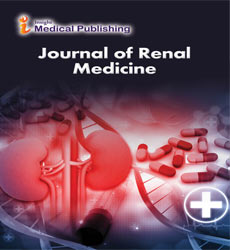Biopsy of Renal Tumors Reveals a Wide Range of Neoplastic Conditions
Mohamad Ziya*
Department of Neurosurgery, Johns Hopkins University School of Medicine, Baltimore, USA
- *Corresponding Author:
- Mohamad Ziya
Department of Neurosurgery, Johns Hopkins University School of Medicine, Baltimore,
USA,
E-mail: ziya@yahoo.com
Received date: April 15, 2024, Manuscript No. IPJRM-24-19163; Editor assigned date: April 18, 2024, PreQC No. IPJRM-24-19163 (PQ); Reviewed date: May 02, 2024, QC No. IPJRM-24-19163; Revised date: May 09, 2024, Manuscript No. IPJRM-24-19163 (R); Published date: May 16, 2024, DOI: 10.36648/ipjrm.7.3.27
Citation: Ziya M (2024) Biopsy of Renal Tumors Reveals a Wide Range of Neoplastic Conditions. Jour Ren Med Vol. 7 No.3: 27.
Description
Renal tumor biopsy serves as a significant diagnostic tool in the evaluation of renal masses, for treatment planning and prognostication. This comprehensive guide of renal tumor biopsy, including techniques, histopathological interpretation, clinical implications, and recent advancements in the field. Understanding the intricacies of renal tumor biopsy is essential for healthcare professionals involved in the care of patients with renal tumors. Renal tumor biopsy is an indispensable tool in the multidisciplinary management of renal masses, providing essential diagnostic and prognostic information to guide treatment decisions and optimize patient outcomes. By understanding the various aspects of renal tumor biopsy, including procedural techniques, histopathological interpretation, clinical implications, and recent advancements, healthcare professionals can deliver personalized, evidencebased care to patients with renal tumors, ultimately improving survival and quality of life.
Renal tumors
Renal tumors encompass a diverse group of neoplasms arising from the kidney parenchyma, each with unique histological features, clinical behavior, and treatment implications. While imaging modalities play a central role in the initial evaluation of renal masses, histopathological examination through renal tumor biopsy is essential for accurate diagnosis, determination of tumor subtype, and guidance of personalized treatment strategies. In this we delve into the various renal tumor biopsy, ranging from procedural techniques to histopathological interpretation and clinical implications. Renal tumors represent a spectrum of neoplastic conditions, with Renal Cell Carcinoma (RCC) being the most common primary malignancy of the kidney. Other less frequent renal tumors include transitional cell carcinoma, Wilms tumor, and rare subtypes such as renal sarcomas and oncocytomas. Epidemiological data indicate a rising incidence of renal tumors globally, emphasizing the importance of accurate diagnosis and optimal management strategies. Renal tumor biopsy is indicated in various clinical scenarios, including the characterization of renal masses identified incidentally or through imaging studies like evaluation of solid renal masses suspicious for malignancy on imaging, assessment of metastatic lesions to the kidney, differentiation between benign and malignant renal masses, dentification of histological subtypes to guide treatment decisions.
Techniques of renal tumor biopsy
Several techniques are employed for renal tumor biopsy, each with its advantages, limitations, and potential complications percutaneous biopsy utilizing image-guided needle biopsy techniques, such as ultrasound or Computed Tomography (CT) guidance, percutaneous biopsy allows for sampling of renal masses with minimal invasiveness. Transjugular biopsy in cases where percutaneous access is challenging or contraindicated, transjugular biopsy offers an alternative approach for obtaining tissue samples from renal masses. Open surgical biopsy although less common, open surgical biopsy may be necessary in select cases where percutaneous techniques are deemed inadequate or inconclusive. Biopsy performed during surgical resection of renal tumors provides real-time histopathological information to guide intraoperative decision-making. Histopathological examination of renal tumor biopsy specimens plays a pivotal role in establishing an accurate diagnosis and guiding treatment decisions. Identification of specific histological subtypes of renal tumors, such as clear cell RCC, papillary RCC, chromophobe RCC, and rare variants, based on characteristic morphological features. Assessment of tumor grade and stage according to established classification systems, such as the Fuhrman grading system and the TNM staging system, to stratify patients based on tumor aggressiveness and extent of disease. Immunohistochemical staining for specific markers aids in subtype classification, prognostication, and identification of potential therapeutic targets. Emerging molecular techniques, including next-generation sequencing and gene expression profiling, provide valuable insights into the underlying molecular alterations driving renal tumorigenesis and may guide targeted therapeutic approaches. Recent advancements in renal tumor biopsy techniques and technologies hold promise for further improving diagnostic accuracy and treatment outcomes like the emergence of liquid biopsy techniques, such as circulating tumor DNA (ctDNA) analysis and Circulating Tumor Cell (CTC) enumeration, offers a non-invasive means of monitoring disease burden, detecting molecular alterations, and predicting treatment response in patients with renal tumors. Integration of radiomic analysis, leveraging quantitative imaging features extracted from radiological images with histopathological and molecular data holds potential for enhancing preoperative risk stratification, predicting treatment response, and guiding personalized treatment strategies. Artificial Intelligence (AI) machine learning algorithms and AI-driven approaches are being increasingly utilized for automated image analysis, biopsy site selection, and histopathological interpretation, streamlining the biopsy process and improving diagnostic accuracy.
Open Access Journals
- Aquaculture & Veterinary Science
- Chemistry & Chemical Sciences
- Clinical Sciences
- Engineering
- General Science
- Genetics & Molecular Biology
- Health Care & Nursing
- Immunology & Microbiology
- Materials Science
- Mathematics & Physics
- Medical Sciences
- Neurology & Psychiatry
- Oncology & Cancer Science
- Pharmaceutical Sciences
